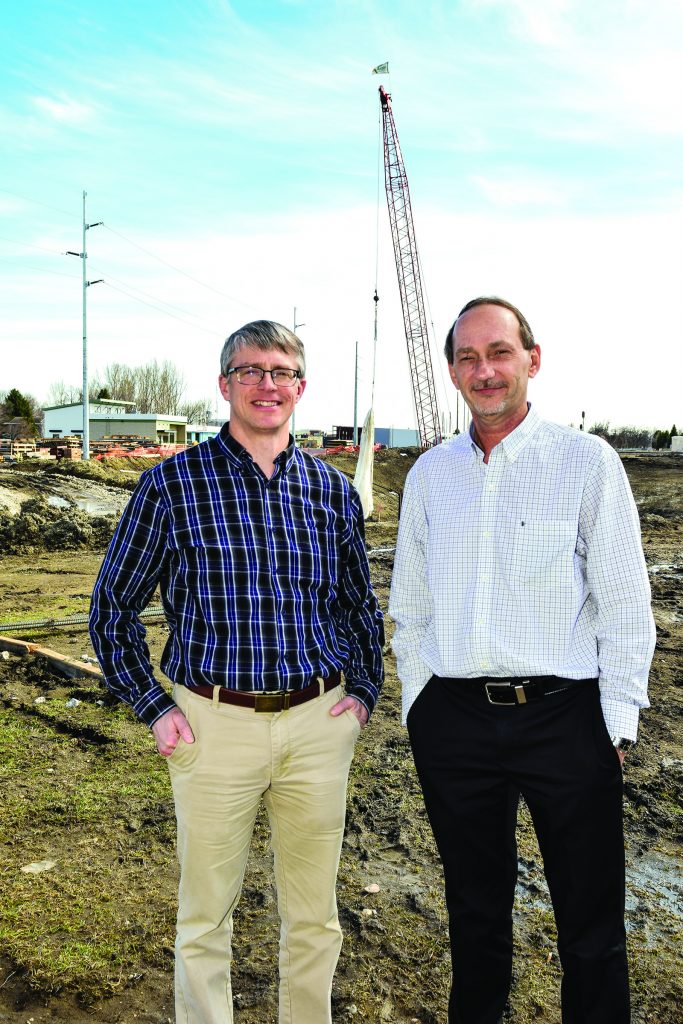
Nancy Edmonds Hanson
hansonnanc@gmail.com
Seven months from now, it will all be worth it. Trains will rumble overhead as traffic flows unobstructed down below. The scrambled asphalt asterisk of Southeast Main, 20th and 21st Streets will be untangled – free of backed-up crossings and safe from the confusion that’s made the notorious confluence of routes just west of Moorhead High School the most notorious, accident-prone spot in town.
That’s then, but this is now: a summer and fall of unprecedented heavy construction, with all the attendant noise, dust and ground vibrations that the city’s largest-ever infrastructure construction project will ultimately entail.
“It’s the single largest project in Moorhead history,” says city engineer Bob Zimmerman … not only in dollars ($72.9 million, when all is said and done) but in time, effort and scope. It dates back more than 20 years, when local conversations began about relocating the always-problematic railroad tracks. They’d been laid smack through the site of the present city 50 years before automobiles arrived to vie for space. When completed late this year, Zimmerman said the new configuration is expected to serve the city’s – and the railroad’s – needs for the next 50 years.
Back in the 1990s, early conversations about moving the tracks outside the city stalled when rural land-owners rejected the idea. Zimmerman credits U.S. Rep. Collin Peterson with securing the first $5.5 million in funding to underwrite serious deliberations on how to smooth the bumps for eastside traffic. The study led to two solutions, both of which will bear fruit by the end of 2019: the 34th Street interchange on Interstate 94 (completed in 2009) and this one.
Between those early studies and this summer lie a series of disappointments, revived hopes and – finally – state funding appropriated by the Minnesota Legislature in 2018. In the end, the construction that started last July is fueled by $48.3 million in state funding, an estimated $13.4 million from the city and $5.7 million from BNSF, along with $1.4 million from Moorhead Public Service Department and substantial amounts by Xcel Energy and other entities. But that white-collar story pales when compared with what it takes to actually carve out the new roads and tracks expected to be opened in November.
Engineer Tom Trowbridge described the massive undertaking in a presentation to Moorhead Rotary last week:
• Three elevated railroad bridges, two of them so close they share an abutment
• One mile of road reconstruction
• Half a mile of retaining walls
• 270,000 cubic yards of heavy clay excavated from the site, hauled in 2,700 truckloads
• 9,400 feet of new storm sewer, along with relocation of one mile of water mains and 500 feet of sanitary sewer
• Relocation of a six-inch natural gas main and many electrical power lines
Meanwhile, the railroad is working on its own sections of the project. First is construction of the 2,000-foot temporary track called a “shoofly” to divert trains around the construction site. After the bridges and roadways are complete, they plan next year to build one of the most welcome features of the project. Known as a “wye,” the new tracks south of Main and west of 20th and 21st Streets will enable trains to make a graceful turn onto the southbound tracks of both BNSF and the Otter Tail Valley Railroad without the current maneuver that annoys automobile drivers most. Mile-long trains now inch west from the Dilworth rail yards through Moorhead at 5 miles per hour, blocking every railroad crossing. Then they laboriously back up to turn onto the southbound rails. That final part of the project is expected to be wrapped up in 2020.
The whole project will shake things up this summer. “There’s going to be a lot of dust, a lot of noise,” Trowbridge warned, “between the pilings and the large-scale nature of the excavation.” The earth will shake from time to time; the engineering department has acquired several vibration monitors that will be moved around to measure the severity of the movement. “We need a baseline in case of complaints about property damage,” he noted.
The present detours, he said, “are working out pretty well.” That includes diverting high school traffic to 34th Street and employing several so-called traffic calming features, including speed feedback signs, extra police enforcement and the temporary roundabout at the eccentric intersection of Birch Lane and Oak Way south of the high school. “Residents have been telling us it’s working well. They like it,” Trowbridge said.
The city has set up several ways to stay up to date through the construction system. One is its e-notification system. To receive the latest information by email, sign up at cityofmoorhead.com/about-the-city/news/sign-up-for-e-notification. Be sure to check the box for “20/21 St Underpass Construction” under “news.”
You can also check out the engineering tab for periodic updates, photos and other news at cityofmoorhead.com/departments/engineering. The site offers several animations that compare the familiar old traffic flow with what’s now being constructed.


